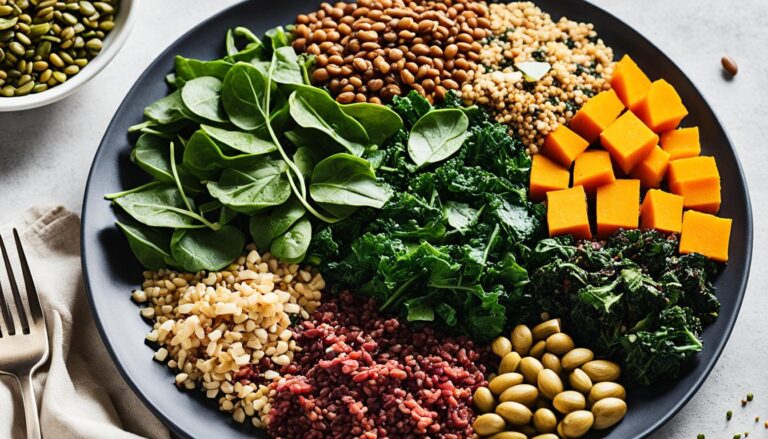Can intermittent fasting really help you achieve your weight loss goals and improve your overall health? The U.S. Obesity rate was 42.4% in 2020. Many people are turning to intermittent fasting as a way to get lean without a drastic diet or calorie reduction. Intermittent fasting for beginners can seem intimidating, but it’s actually a simple and effective way to manage your weight and improve your health.
As a beginner, it’s essential to understand the basics of intermittent fasting and how it can benefit your health. Intermittent fasting involves cycling between periods of fasting and eating. It has been linked to various health benefits, including weight loss, improved cognitive function, and reduced inflammation. With intermittent fasting, you can preserve muscle mass better than traditional calorie-restricted diets and reduce waist circumference by around 4%–7%, particularly targeting belly fat.
Key Takeaways
- Intermittent fasting can result in a 3%–8% weight loss over 3–24 weeks
- Intermittent fasting can help preserve muscle mass while losing fat
- There are different intermittent fasting schedules available, including the 16:8 method and the 5:2 diet
- Intermittent fasting may reduce the risk of cancer and cardiovascular disease
- It’s essential to consult with a healthcare provider before starting any new diet or fasting regimen, especially if you have any underlying health conditions
- Intermittent fasting can be easier to adhere to than traditional diets, as participants quickly adapt to the routine
Understanding Intermittent Fasting: The Basics
Intermittent fasting means you don’t eat for certain times, from 12 hours to days. It helps with weight loss and has health perks. Picking the right method is key to meeting your goals.
There are many ways to do intermittent fasting, like the 16/8 method and the 5:2 diet. Each has its own good and bad points. Knowing the science behind fasting helps you choose wisely.
What Is Intermittent Fasting?
Intermittent fasting isn’t a diet but a way to eat. It alternates eating and fasting to aid in weight loss and health. It may also protect against heart disease and Alzheimer’s.

The Science Behind Fasting
Fasting changes your body in good ways. It boosts HGH, promotes autophagy, and lowers insulin. It also helps your body burn fat.
| Method | Description |
|---|---|
| 16/8 Method | Fasting for 16 hours, eating within an 8-hour window |
| 5:2 Diet | Restricting caloric intake to 500-600 calories on fasting days |
| Alternate-Day Fasting | Alternating days of normal eating with days of caloric restriction |
Learning about intermittent fasting and picking the right method can boost your health and wellbeing.
Benefits of Incorporating Intermittent Fasting into Your Lifestyle
Starting with intermittent fasting can change your life for the better. It helps with weight loss and boosts your health. You’ll see better insulin sensitivity, less inflammation, and sharper thinking. Weight loss tips often talk about cutting calories, but fasting is a different way to do it.
Here are some main benefits of intermittent fasting:
- Less risk of chronic diseases like heart disease and type 2 diabetes
- Better mental clarity and focus
- More energy
- More autophagy, which means your body cleans itself by getting rid of damaged cells and proteins
Finding the right fasting method is key. You might try the 16/8 method, the 5:2 diet, or something else. The important thing is to stick with it and be patient. Over time, your body will adjust, and you’ll start to see the benefits.

Starting your fasting journey? Remember to drink plenty of water, listen to your body, and talk to a doctor if you’re worried. With the right attitude and method, fasting can help you reach your health and weight goals.
Popular Intermittent Fasting Methods
Intermittent fasting is popular for its health benefits like weight loss and better insulin sensitivity. There are many methods to try, each with its own advantages and challenges. The 16/8 method means fasting for 16 hours and eating in an 8-hour window. The 5:2 diet involves eating normally for 5 days and then eating only 500-600 calories for 2 days.
The eat-stop-eat method means fasting for 24 hours once or twice a week. Alternate day fasting involves alternating between normal eating days and calorie-restricted days. It’s important to pick a method that fits your lifestyle and goals for success.

When picking an intermittent fasting method, think about your schedule, dietary needs, and health goals. For example, the 16/8 method is good for busy people, while the 5:2 diet is better for losing weight. Success comes from finding a method you can keep up with and combining it with a healthy diet and exercise.
The Benefits of Each Method
- The 16/8 method can improve insulin sensitivity and increase fat burning
- The 5:2 diet can promote weight loss and reduce inflammation
- The eat-stop-eat method can improve cellular cleaning and reduce oxidative stress
- Alternate day fasting can improve cardiovascular health and increase human growth hormone production
Always talk to a healthcare professional before starting any new diet or fasting plan, especially if you have health issues. With the right approach and mindset, intermittent fasting can be a powerful tool for achieving optimal health and well-being.
Getting Started with Your Fasting Journey
Starting an intermittent fasting journey can be tough, but it’s worth it. Setting realistic goals and listening to your body is key. Begin with an 8-hour eating window and a 16-hour fasting window.
Stay hydrated with water, sparkling water, and tea. Coconut MCT oil can help with insulin levels. Eggs, chicken, fruits, yogurt, and avocado are good foods to break your fast.

Intermittent fasting can help with weight loss. It makes you more aware of hunger and boosts energy and mood. It also increases metabolism and fat burning.
To keep a healthy fasting routine, follow these weight loss tips:
- Start with a 12-hour fasting period and adjust as needed
- Stay hydrated with non-caloric beverages
- Choose nutrient-dense foods when breaking your fast
- Be consistent, but allow for occasional deviations
Remember, fasting is a journey. Be patient and listen to your body. With the right mindset, you can reach your weight loss goals and improve your health.
What to Eat During Your Eating Windows
When you’re fasting, it’s key to eat whole, nutrient-rich foods. This means fruits, veggies, lean proteins, and healthy fats. A good diet helps you reach your health goals, like losing weight or feeling better overall.
Great foods for fasting include avocado, potatoes, and cruciferous veggies. Also, fish, seafood, whole grains, nuts, and fermented foods are good. These foods are full of nutrients, fiber, and healthy fats. They help you feel full and happy during your eating times.

- Focus on whole, unprocessed foods
- Incorporate a variety of fruits and vegetables into your diet
- Choose lean protein sources, such as fish and poultry
- Healthy fats, such as avocado and nuts, can help keep you full and satisfied
Drinking water is also very important when fasting. Drink lots of water during your eating times. You can also try herbal tea or broth. By following these tips and fasting, you can reach your health goals and eat well.
| Food | Nutritional Benefits |
|---|---|
| Avocado | Rich in healthy fats and fiber |
| Fish and Seafood | High in protein and omega-3 fatty acids |
| Cruciferous Vegetables | Rich in fiber and antioxidants |
Common Challenges and How to Overcome Them
Starting intermittent fasting can be tough. You might feel hungry, crave certain foods, or worry about what others think. But, with the right mindset and support, you can beat these hurdles. Managing hunger and cravings is key. This can be done by drinking plenty of water and eating foods rich in nutrients during your eating times.
Some common fasting challenges include:
- Hunger and cravings
- Social pressures and eating with others
- Staying motivated and tracking progress
To tackle these issues, knowing good weight loss tips is crucial. This means eating foods that are good for you, drinking lots of water, and finding healthy ways to deal with stress and feelings. By doing this, you can make fasting a part of your life and reach your weight loss goals.
Tracking Your Progress and Making Adjustments
Tracking your progress is key when you’re fasting intermittently. It helps you reach your health goals. Use apps like Zero to track your fasting and eating habits. It lets you set goals for fasting hours and calorie intake.
A bullet journal is also great for tracking. It helps you stay motivated and on track. By tracking, you can see patterns and make changes to your fasting schedule.
- Setting realistic fasting goals, such as increasing your fasting hours or improving your eating habits
- Monitoring your calorie intake during the eating window to ensure you’re meeting your nutritional needs
- Tracking your physical and mental well-being, including energy levels, mood, and overall health
Following these tips and adding fasting to your life can help you reach your health goals. Stay consistent, be patient, and adjust as needed for the best results.
Safety Considerations and Potential Side Effects
When you start intermittent fasting, safety is key. Intermittent fasting isn’t for everyone, especially those with health issues or on certain meds. Always talk to a doctor before starting any new diet or fasting plan, like fasting.
Some people should not try intermittent fasting without a doctor’s okay. This includes those with diabetes, heart, kidney, or liver diseases. Also, people with eating disorders, pregnant or breastfeeding women, and those on specific meds should be careful. Safety considerations are important to avoid side effects like hunger, headaches, and mood swings.
Who Should Not Fast
- Individuals over 65
- Children, teens, and young adults
- Those with diabetes, heart, kidney, or liver diseases
- Pregnant or breastfeeding women
- Individuals with a history of eating disorders
Watch out for warning signs like dizziness, fainting, or extreme hunger. If you see these, talk to a doctor right away. Knowing the risks and taking steps to avoid them will help you have a safe and successful fasting journey.
When to Consult a Healthcare Provider
If you’re thinking about intermittent fasting, talk to a doctor first. They can help you understand the benefits and risks. This way, you can make sure you’re safe and set up for success with fasting.
Combining Intermittent Fasting with Exercise
When you mix intermittent fasting with exercise, it’s key to listen to your body. This helps you adjust your routine as needed. Studies show that fasting before exercise might use muscle for energy, which could lead to muscle loss. Yet, intermittent fasting can also boost the benefits of exercise. It can improve insulin sensitivity, lower blood pressure, and better cholesterol levels.
Some important things to think about when you’re doing both intermittent fasting and exercise include:
- Timing of meals: low-intensity cardio might work well for fasting workouts. But high-intensity cardio, longer workouts, and strength training might need to be done when you’re eating.
- Hydration and electrolytes: it’s vital to stay hydrated and get enough electrolytes. This helps keep you feeling good and performing well during intermittent fasting and exercise.
- Listening to your body: always pay attention to how your body feels during workouts. Adjust your routine as needed.
A study showed that cardio exercises like walking or light cycling can help reduce body fat and waist size. They also improve aerobic capacity and help manage hunger and cravings. Strength training can help lose fat, increase metabolic rate, and manage hunger and cravings. It also helps keep muscle mass. By combining intermittent fasting with exercise, you can lead a healthier and more balanced life.
| Exercise Type | Benefits | Considerations |
|---|---|---|
| Cardio | Decreases body fat, improves aerobic capacity | Low-intensity cardio may be suitable for fasting workouts |
| Strength Training | Helps in losing fat, increases metabolic rate | Requires more carbohydrates and protein after workout |
Conclusion: Your Path to Successful Intermittent Fasting
Starting your intermittent fasting journey? Remember, patience and persistence are crucial. Changing your lifestyle takes time, but the benefits are worth it. You might want to lose weight, improve your health, or boost your brain power.
Keep yourself motivated by tracking your progress and celebrating small wins. Use fasting apps and join online fasting communities for support. Everyone is different, so listen to your body and adjust as needed.
By following this guide and adding intermittent fasting to your life, you’re on the path to a healthier you. Embrace the journey, stay committed, and discover the power of this ancient practice. Your journey to successful intermittent fasting starts now.





